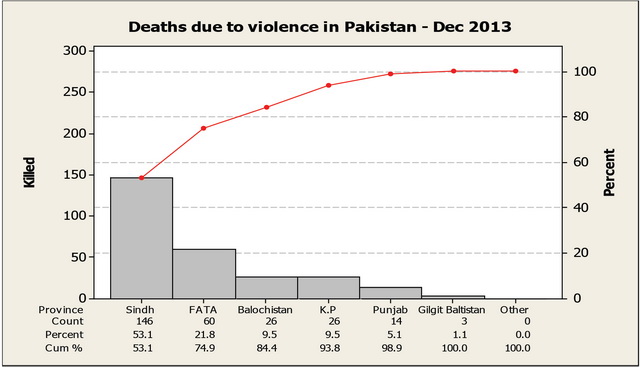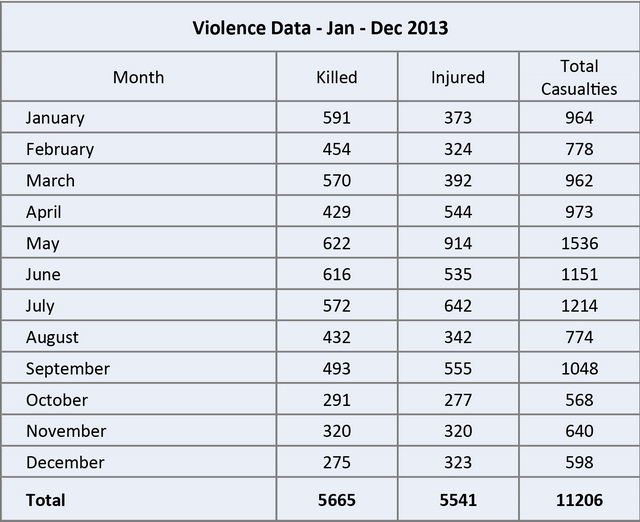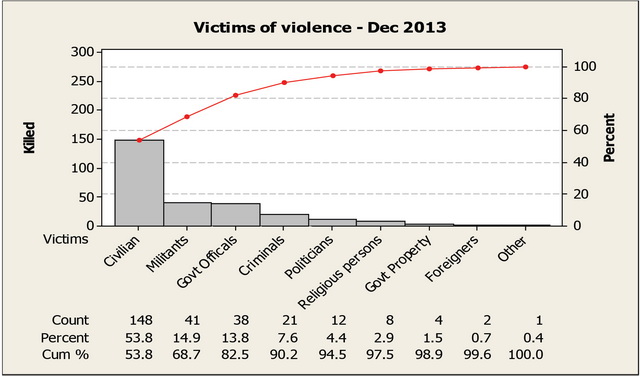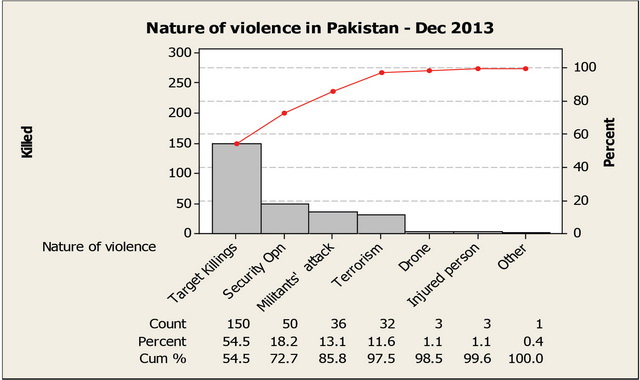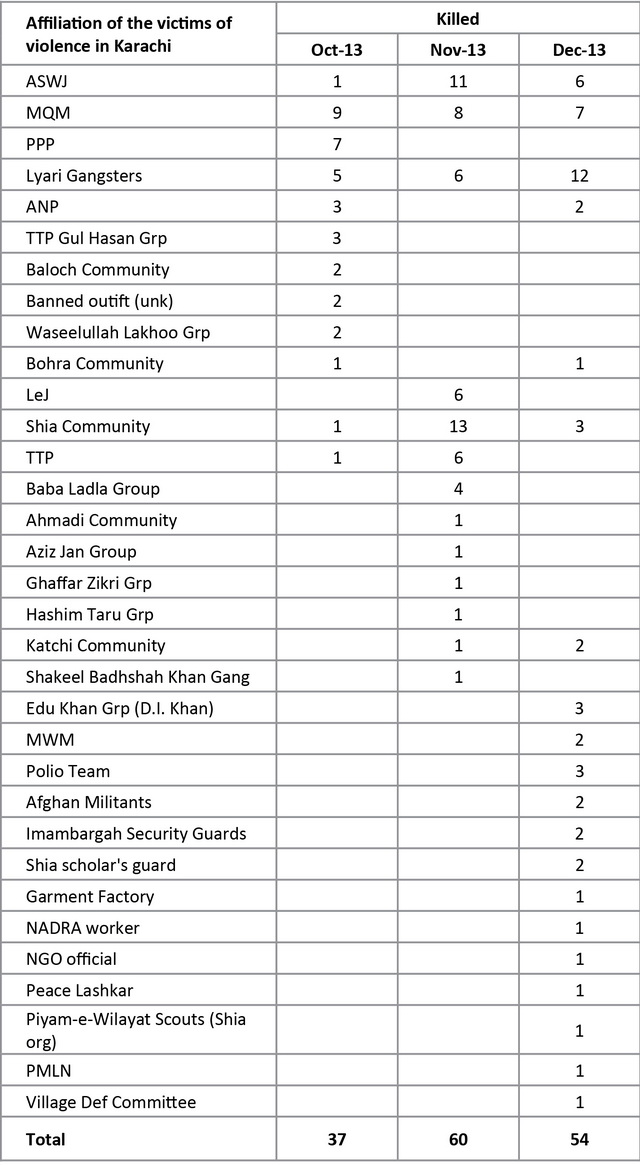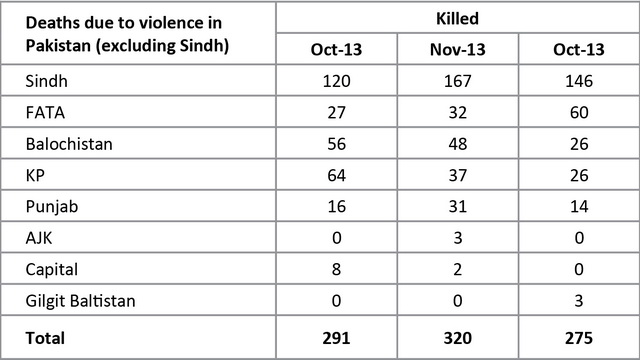The month of December saw a moderate reduction in the number of casualties related to militant, sectarian and politically-motivated violence plaguing Pakistan.
The overall death toll was at around 275 while up to 325 people were wounded in these hostilities bringing the total number of deaths in 2013 to 5665. The figures recorded in November stood at 320 deaths and 320 wounded.
It is, however, difficult to ascertain as to what exactly led to the decline in violence in view of the prevailing confusion that surrounds efforts Prime Minister Nawaz Sharif government is making to shape up an effective national security policy to end the bloodshed in the country.
A deadly suicide bombing against a security post in the town of Mir Ali in North Waziristan in mid December that killed several soldiers provoked the military to launch a massive retaliatory offensive in the region, involving ground and air raids, allegedly killed nearly three dozen militants mostly Uzbeks.
While the army insisted the offensive was carefully planned to avoid collateral damage, residents in the area accused security forces of killing mostly civilians. But the both the accounts as usual were difficult to confirm because the remote tribal region remains inaccessible to journalists and aid workers.
The operation prompted nationwide media speculations that a long-awaited military offensive against suspected militant bases in North Waziristan was finally either underway or about to be launched. But the army rejected these reports as unfounded, insisting the offensive was just meant to punish planners of the December 18 suicide bombing.
Critics suggested the talk of a possible large-scale military offensive might have discouraged militants from carrying out subversive acts elsewhere in Pakistan and instead focused on fortifying their traditional bases to prepare for the reported army operation.
Meanwhile, authorities claimed that violence also went down in Karachi during the month because of the ongoing operation targeting criminal elements in the city. They cited nearly 40 percent reduction in ‘incidents of murders’ in Karachi since the operation was launched and the trend continued into December.
The outgoing year witnessed a rise in Shia-Sunni violence but targeted killings of top scholars from both the Muslim sects in December particularly in Punjab gave a new alarming dimension to the religious rivalry that has claimed thousands of lives in Pakistan over the years.
All these events and other facts reported in the national newspapers are collected to make this report as informative and factual as possible.Errors and omissions, as always a possibility in all statistical works including this one, are expected.However, such mistakes do not grossly affect the basic objective of this report.This report mainly covers the following topics:
Target killings and targeted operation in Karachi
Sectarianism violence
Declining rate of violence
Drone Attacks and security operation
CRSS will appreciate receiving comments that the readers may have on this report.
Report prepared by:
Mohammad Nafees
Senior Research Fellow
Center for Research and Security Studies
Data compilation by:
Fariha Farry
NOTE: Readers can approach CRSS for source of any information included in the report. Please send your request to: [mail@crss.pk]
OVERVIEW
Deaths due to violence in the country during June 2013:
Deaths resulted by violence in the country witnessed as the lowest in the whole year during this month (275 deaths and 323 injured). However, the situation in Karachi remained unchanged with no sign of decline in losses of human lives (Refer graph 1 and 3). North Waziristan Agency (NWA) and Peshawar were the two other places that followed Karachi in human losses and the major causes of them were the militants– attack and the resultant military operation in NWA.
Graph 1: Number of people killed in provinces due to violence:
Graph 2: Casualties of violence ´ Jan ´ Dec 2013:
Table 1: Casualties of violence ´ Jan ´ Dec 2013:
Graph 3: Number of persons killed in cities in December 2013:
After civilians, militants and government officials were the highest victims of violence that speak well of the security measures taken by the law enforcing agencies to curb the militancy in the country (Refer graph 4). However, the menace of terrorism still remains very much active and alive when we look at the number of fatal incidents that took place in the country during this month.
42 Bomb attacks,
7 Grenade attacks,
5 Rocket attacks
4 Landmines,
3 IED,
3 Indiscriminate firings
3 Suicide attacks
Graph 4: Victims of violence in December 2013:
Nature of violence:
Target killings continue to be the most common method for the criminals irrespective of the motivation that drives them to resort to such violence. Sectarian hatred, political rivalry, land grabbing, and anti-state insurgency remained the common causes that led to target continued killings in the country. Militants– attacks (armed attacks, suicide attacks, rocket attacks, hand grenade attacks and indiscriminate firings) and acts of terrorism (bomb placement, planting of IED and land mines) are the methods commonly used by the militants and insurgents to inflict death and destruction in the country (Refer graph 5).
Graph 5: Nature of violence in Pakistan ´ December 2013:
Target killings and targeted operation in Karachi:
Newspaper reports claim that the targeted operation in Karachi resulted in apprehension of nearly 1400 suspects during the month of December 2013. Among the captives were the militants belonging to TTP, LeJ, and Lyari gangs. Three criminals reportedly affiliated with a political party [no name of the party was mentioned in the report] were also arrested from the city who had confessed of killing workers of PPP and ANP[1]. In another report, the police claimed to have arrested a key Pakistani Taliban commander, Abu Hamza, during a raid in Karachi West Wharf area on 14 December, who was allegedly involved in murders of policemen and soldiers[2]. In a press briefing, Crime Investigation Department (CID) also made a startling revelation that there are 10 militant groups operating in Karachi and a local chief of Lashkar-e-Jhangvi (LeJ) Hafiz Qasim Rasheed operates from Central Jail Karachi and issues directives to terrorists for carrying out terror activities in the city[3]. Despite capturing so many criminals and key figures of militant organizations, the crime rate in Karachi witnessed only 10% reduction as compared to last month crime rate (138 in December versus 156 in November).
The targeted operation in Karachi has exacerbated the rivalry among different criminal groups operating in Lyari area. The turf war between these groups remained a continued phenomenon. Fourteen persons lost their lives in Lyari gang war and the victims were from groups like Uzair Baloch, Wasiullah Lakhoo, Sardar Asif Baloch, and Kutchi community.
The sectarian violence took its tolls in the city as well and most of the victims were from the two main Islmaic sects – Sunni and Shia. The security guards providing security to an Imambargah and to a Shia scholar were also been targeted. A slight relief that was noticeable is the significant reduction in sectarian violence in Karachi which came down from 31 victims in November to 15 victims during this month, a decline of more than 50% (Refer table 3).
Table 2: Affiliation of the victims of violence in Karachi Oct ´ Dec 2013:
Note: Numbers in red color identify victims of target killings in Karachi that were motivated by sectarian hatred.
Sectarianism violence:
The wave of sectarian violence that swept the country last month continued striking this month as well. Fifteen persons in Sindh and four in Punjab lost their lives to sectarian violence in the country besides a failed attempt of two suicide women at an Imambargah in Karachi[4]. To further worsen the sectarian divide and hatred in the country, a well-planned targeting of the senior leaders of the religious belonging to Shia and Sunni sects was carried out in the Punjab and Sindh. The religious leaders targeted this month were:
December 4, 2013
Karachi: A senior leader of the Majlis-e-Wahdat-e-Muslimeen (MWM), Allama Deedar Ali Jalbani,was shot dead along with his security guard on the University Road[5].
December 7, 2013
Lahore: A provincial head of Ahle Sunnat Wal Jamaat (ASWJ), Maulana Shamsur Rehman Muawiya, was shot dead in Lahore on Friday[6].
December 12, 2013
Karachi A prayer leader affiliated with the Ahle Sunnat Wal Jamaat, Qari Muhammad Usman Abbasi, fell victim to gun attacks in Gulshan-e-Iqbal[7].
December 16, 2013
Lahore: A leader of the Majlis Wahdat-e-Muslimeen (MWM) Allama Nasir Abbas Multani was shot dead[8].
A tit-for-tat strategy seems to have become a norm for the sectarian outfits to settle their accounts and Lahore and Karachi (the two mega cities of the country) have been seen as the battle grounds to bring validity to the militants– threat of spreading violence to the Punjab and other settled areas of the country.
Declining rate of violence:
Other than FATA, the crime rate in the rest of the country came down significantly during the month of December. In FATA, the number of persons died due to violence and counter violence operation was almost double of the last month figure (Refer table 4). Balochistan and KP recorded nearly 50% reduction in crime rate when compared to the figure of October. Both of these provinces have been witnessing gradual decline in rate of violence since October 2013 and its possible causes seem to be the effective security measures and the change in militants– agenda that has been seemingly shifted its focus on Punjab and Sindh.
Table 3: Deaths due to violence in Pakistan
Drone Attacks and security operation:
While the controversy over the effectiveness and legality of drone attacks was going on in the country, a suicide attack on an army camp in Khajori on 18 December leaving 5 soldiers dead and many injured led the army to react strongly against the militants using ground forces and air raids. The official report of the military operation reported death of 33 militants, mostly foreign nationals[9]. As soon as the report of the operation appeared in the press, a debate in the press ensued suspecting the authenticity of the official claim. Religious parties like Jamat-e-Islami (JI), Defa-e-Pakistan Council (DPC), and Jamiat Ulema-i-Islam – Fazl (JUI-F) condemned the military operation while the mainstream political party Pakistan Tehreek-e-Insaf (PTI) raised its concern on carrying out the operation without taking the nation into confidence[10]. Chief of JUI-F, Fazlur Rehman, disproved military claim of suicide attack on its convoy in North Waziristan by saying that the area was under curfew at that particular time. He aslo claimed that the number of people killed in the operation was 65 and all of them were innocent civilians[11]. Taliban reaction was no different either. They dismissed the possibility of peace talk when a military operation was under way and vowed to fight back if a large scale military operation is carried out in the North Waziristan.
Besides, Taliban accused Pak Army of working on US agenda[12]. What all these critiques of military operation forgot to notice was the number of militants– attack during this month. Militants carried out nearly fifteen attacks throughout the country and killed 28 persons and injured 61. Prior to the attack on army camp in Khajori, a military convoy was attacked in Spinwam area of North Waziristan also that had left four soldiers dead and 11 injured[13]. Faced with so frequent militants– attacks, army retaliated by immediate operation against the militants.
The reports appeared in some local and international press provided conflicting information on the way the operation was carried out and they did talk of civilian casualties. Countering such allegations the Defence Minister, Khawaja Muhammad Asif defended the right of self defence against attacks on the security forces. What this controversy reveals is the most complex problem faced by the country in dealing with the menace of terrorism when not only the drone attacks but the military operations also result in civilian casualties raising criticism and condemnation from different sections of the society.
To the shock of opponents of military operation and drone attacks, a drone entered the territory of the country on 26 December and killed three militants suspected to be of Afghan origin[14]. The incident raised no condemnation or criticism and all went as normal.
Conclusion:
The crime rate in the country has been showing a decline since October and it is a very healthy sign for the country that has been suffering from violence for over a decade now. However, it cannot be determined in actual terms whether this improvement in law and order situation could be attributed to the vigilance of the law enforcing agencies or it is result of serious setback to the militant organizations during the last three months when they lost most of their key leaders in drone attacks and the targeted operations by the law enforcing agencies. Irrespective of the downward trend of the crime rate, the menace of violence in different shapes and forms still exist in the country and has continually been consuming human lives every day.
The upsurge in sectarian violence and gang war during the last two months is an example of the maneuverability of the forces that want to keep the country in the grip of lawlessness. Target killing of the four leading religious scholars in the Punjab and Sindh was another similar attempt that remained unsuccessful to flare up sectarian violence in the country in general.
[3] http://www.dailytimes.com.pk/default.asp?page=2013\12\08\story_8-12-2013_pg7_11
[4] http://www.dawn.com/news/1074841/attack-on-karachi-imambargah-foiled
[8] http://www.thenews.com.pk/Todays-News-13-27319-Religious-leader-shot-dead-in-Lahore
[9] http://tribune.com.pk/story/647627/brazen-assault-north-waziristan-suicide-attack-leaves-five-soldiers-dead/
[10] http://tribune.com.pk/story/648983/operation-in-waziristan-govt-must-take-nation-into-confidence-says-imran/

